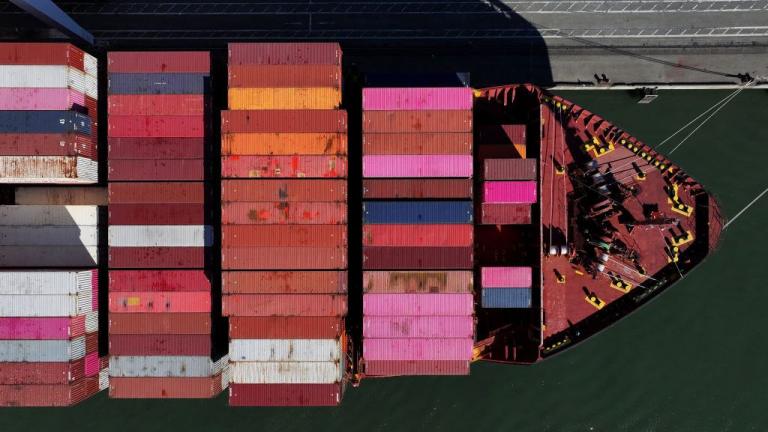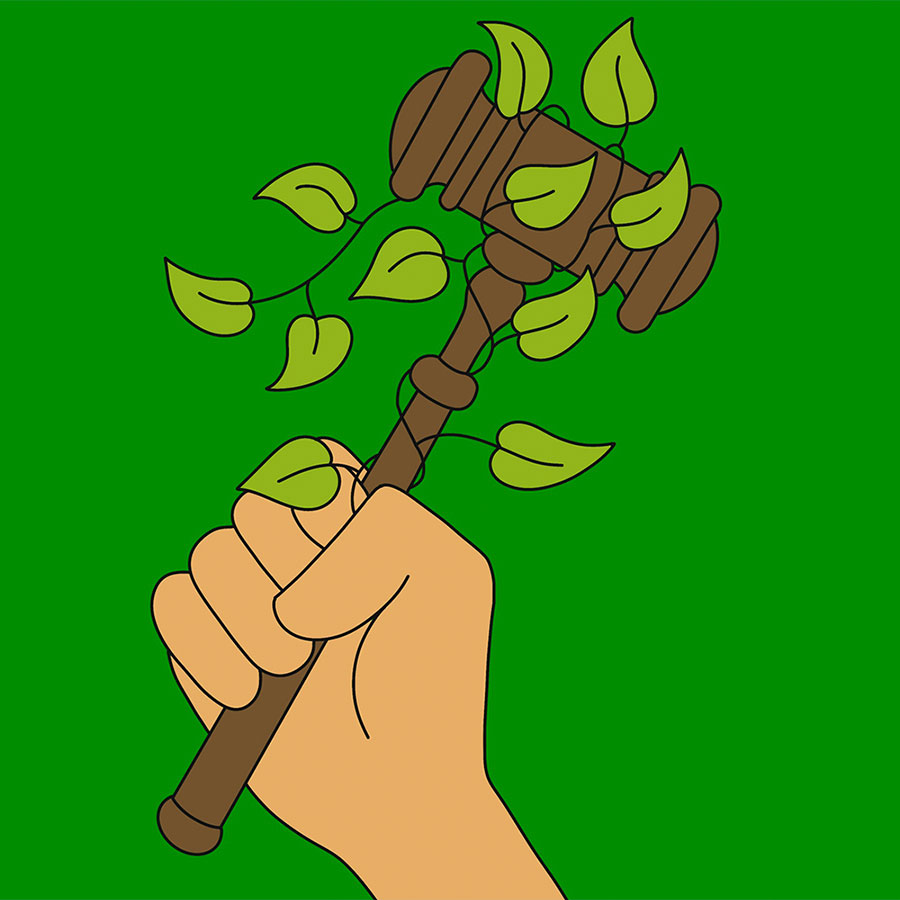
We’ve arrived at Day 7, and the final piece in our Cities + Solutions series! We thank you for joining us on this journey, and we hope you’ve enjoyed learning about these case studies in local climate leadership across the nation. Below today’s story, you’ll find a link to share your feedback on the series.
If you absolutely loved it, and you’d like to see more special runs like this in Looking Forward — that’s great! We’re so happy to hear it! And we would be honored if you’d consider supporting Grist so that we can keep bringing you stories of hope and action. (If you didn’t love it, or have feedback, we want to hear that as well, so we can keep making this newsletter better.)
For our final piece — a newsletter exclusive — writer Syris Valentine chronicles the origins and efforts of the community oversight board guiding Seattle’s Green New Deal (of which he is a member). But more than a story about the Emerald City’s efforts, this concluding piece is a reflection on the important role that residents play in igniting and supporting climate action where they live.
— Claire Elise Thompson
The spotlight
Dear Reader,
I know you’re scared. I am, too. But there’s reason to hope.
Yes, existing national climate plans are “insufficient.” Yes, catastrophe feels imminent. But remember: Our world is not made of countries, but of communities. We may struggle to sway state structures, but we can shape our destinies from within our neighborhoods and our cities. This is the lesson Seattle’s Green New Deal and its oversight board offer.
I’m telling you this not as a youth representative on the board nor as its co-chair. I’m telling you this as a young adult who often looks to the future with fear, but has found hope in the power of fighting to change the systems of my city (despite the frustrations that can come with the work).
Since our first meeting in September 2021, the board, composed of 19 city-appointed community representatives, has advised the mayor and city council on municipal climate policies, crafted a community-driven vision for Seattle’s Green New Deal, and recommended citywide budget priorities aligned with environmental justice. This wouldn’t have been possible without the grassroots campaign to establish the Green New Deal, dedicated board members who are willing to have difficult conversations, a shared commitment to climate justice, and a willingness to make mistakes and learn. Together, the people of Seattle have shown the green revolution will not come from presidential proclamation or congressional decree. Rather, it will be a green reconstruction won city by city, neighborhood by neighborhood, day by day, as together we conceive of and co-create regenerative, just communities.
Seattle’s Green New Deal emerged in the months after young activists with the Sunrise Movement organized a sit-in at House Speaker Nancy Pelosi’s office in 2018. Jess Wallach, a fellow member of the board and staff member at 350 Seattle, remembers joining her colleagues for dinner and grappling with the difficulty of pushing for national policy change from the local level. Then someone asked, “What would it look like to have a Green New Deal for Seattle?”
The discussion stretched on for weeks and pulled in dozens of organizers from Indigenous-led and frontline-focused organizations as well as from environmental nonprofits.
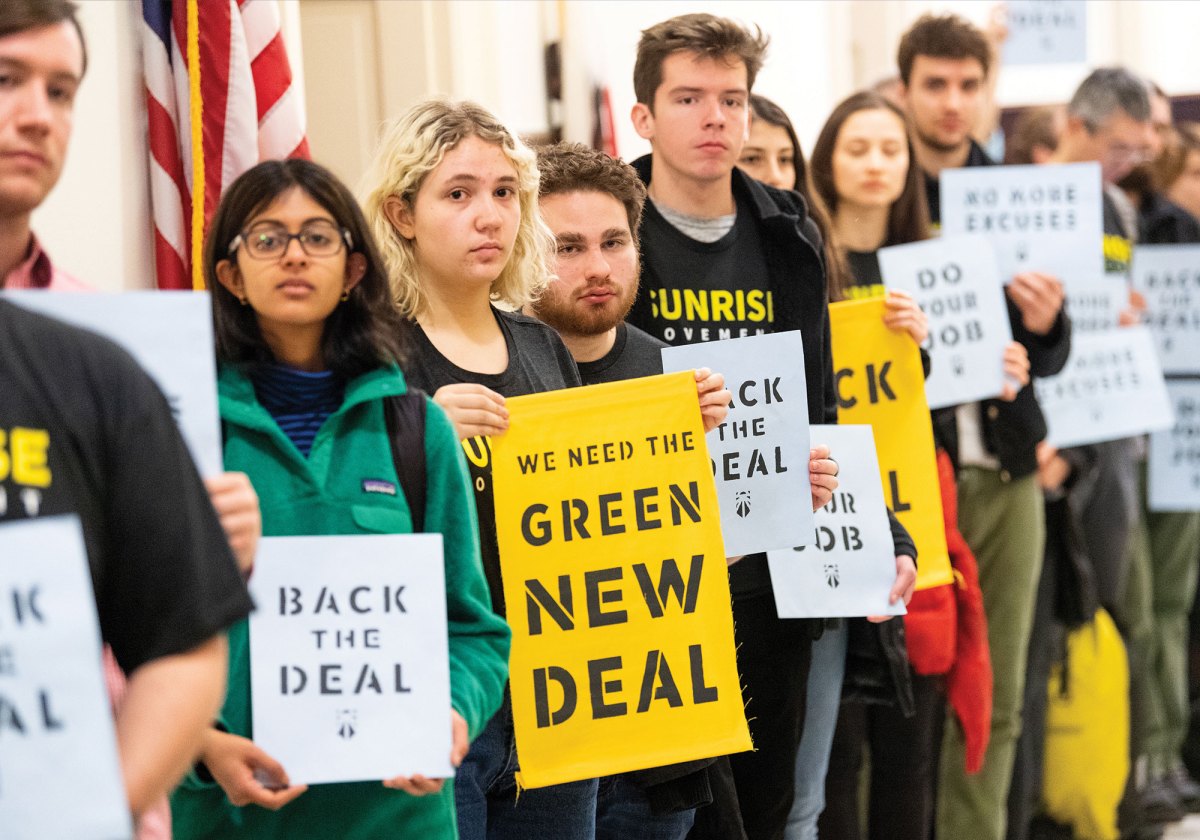
The Sunrise Movement’s protest inside the office of US Representative Nancy Pelosi in 2018 in support of the Green New Deal provided a catalyst for similar legislation in Seattle. Michael Brochstein / SOPA Images / LightRocket / Getty Images
As the coalition formed, momentum gathered, and over just four months in 2019, it put the city on a new path. In June of that year, more than 100 Seattleites flooded city hall to deliver a letter to then-Mayor Jenny Durkan, demanding the city eliminate all emissions by 2030. That August, during a meeting packed with even more concerned citizens, the city council passed a Green New Deal resolution committing to the 2030 goal, affirming the importance of a just transition, and outlining strategies to become carbon-free in an equitable way. By September, an ordinance had established the oversight board that I now sit on.
This wouldn’t have happened without a strong grassroots campaign. Wallach describes the recipe for organizers’ rapid success as equal parts building robust relationships among community partners, maintaining public pressure on city officials, and forging an alliance with a supportive city council member. Taken together, these actions created a strong “inside-outside game.” It also helped that the legislation didn’t touch the tax code; funding would come later.
Still, that quick victory offered an important lesson: Pace yourself. Yes, we’re in a crisis. Yes, we have a tight timeline. But if you move too fast or lead with excess urgency, you risk burning people out or leaving them behind.
“We didn’t organize with labor early enough,” explains Debolina Banerjee, Green New Deal board member and Puget Sound Sage policy analyst. Unions felt like they were being asked to support something they didn’t help shape. Eventually, the coalition won labor support, but it cost time, energy, and effort that could have been saved by reaching out at the start.
From the beginning, however, the coalition centered those directly impacted by the climate crisis. Matt Remle, another oversight board member and cofounder of the Indigenous rights organization Mazaska Talks, says the coalition avoided tokenizing by coordinating with representatives from environmental justice organizations and giving them the gavel — not just a seat at the table. While working with then-council member Mike O’Brien’s office to craft the resolution and ordinance, frontline voices were prioritized in defining agendas and goals as well as directing the shape the legislation would take. In the end, frontline communities won eight of the 19 seats on the board to ensure their concerns were heard and amplified.

Seattle Mayor Bruce Harrell, city staff, and advocates celebrate the signing of the city’s Green New Deal Opportunity Fund investments. The author, Syris Valentine, is shown on the far right. © Ron Wurzer / AP / C40
While COVID delayed the board’s official formation, the city passed a progressive payroll tax called JumpStart to provide emergency pandemic funding for a year, and then support affordable housing, small businesses, equitable development, and the Green New Deal. Once the board convened in late 2021, we sent out surveys and organized listening sessions to garner input on how best to put the Green New Deal funds to work. The board distilled more than 100 suggestions into a package of 15 recommendations, which included investing in climate resilience, electrifying Seattle’s fleet of vehicles, and supporting sustainability projects led by local tribes. These were then delivered to the mayor and city council in an 18-page report to inform their budget process.
But our work only started when we submitted our report. Over the past two years, the city has diverted a sizable fraction of JumpStart revenue to the general fund, forcing the board to urge the city to erect guardrails around JumpStart to prevent further incursions. We’ve also had to respond to the mayor’s proposed budget, which lifted up some of our recommendations, left others unaddressed, and included items our communities never called for. To do both, we drafted a letter outlining our objections, and we encouraged our community members to attend the city council’s budget deliberations to voice their concerns. City council members heard our concerns and proposed several budget amendments aligned with our suggestions.
Our work has helped make Seattle an international leader in building a climate movement, but it remains an imperfect place. The city strives for equity and climate justice, yet white residents are overrepresented in its clean energy workforce, displacement persists for low-income families, and communities of color throughout South Seattle continue to experience disproportionate exposure to pollution from industry, aviation, and transportation. These are among the issues the board aims to address moving forward. To do this, we’re seeking ways to deepen our advocacy for progressive policies on the scale of the climate crisis as we elevate community-driven solutions. This will likely mean forming a new policy committee and expanding our outreach efforts.
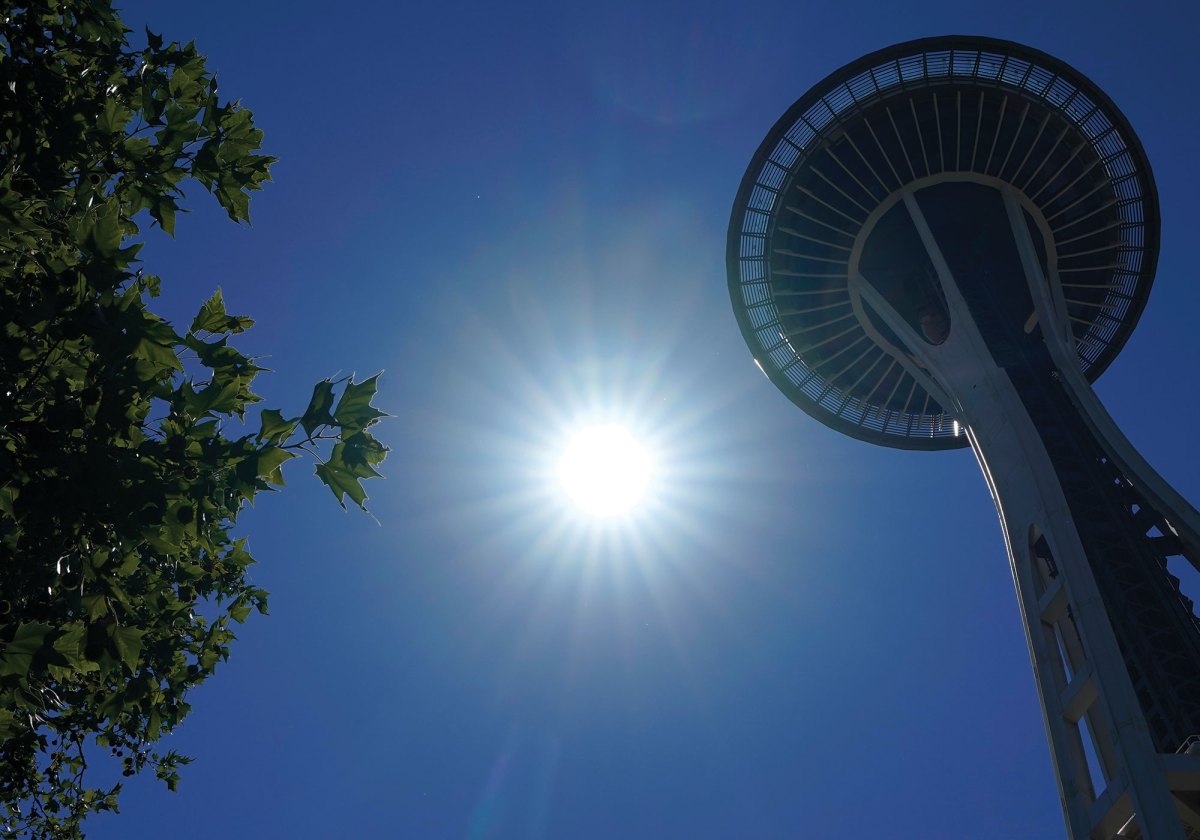
The sun shines down on the Space Needle in Seattle. Ted S. Warren / AP
Although we still have room to grow, the board and our city partners have shaped the investment of more than $27 million to advance environmental justice across Seattle. We’ve won funding to support climate resilience in frontline communities. We’ve advanced programs to electrify multifamily affordable housing and help low-income homeowners transition to electric heating. We’ve recommended programs to diversify the clean energy workforce. And we’re pushing back against proposals that don’t align with what our communities say they need.
Seattle still isn’t on track to eliminate emissions by 2030, but we’ve created the catalyst for a chain reaction of transformative change. Advancing this work, even at the city level, takes energy and effort. But it’s well worth it. As Remle says, “Addressing issues on a local level is one of our only opportunities to make significant changes crafted to the unique needs of our communities.”
While the changes in Seattle have been slow and may seem small, they form but one patch of fabric in a technicolor canvas quilted by communities fighting for our future. As we hoist this canvas as our sail and it unfurls to gather wind, it will carry us across oceans of instability and uncertainty until we reach the land of justice and regeneration lying just below the horizon.
This is how we win.
Sending you peace, love, and power,
Syris Valentine
More exposure
- Read: about the demands for the 2023 budget being put forth by Seattle’s Solidarity Budget coalition (South Seattle Emerald)
- Explore: At the end of last year, Seattle launched an online portal to track progress on its Green New Deal commitments
- Read: Los Angeles, another city with a Green New Deal, has made some solid progress on its goals in the past three years (Spectrum News)
- Read: a feature about France’s Citizens’ Convention for the Climate — an effort to let French citizens direct the country’s climate policy, with mixed results (Grist)
- Read: a piece describing how climate hope can be fueled by action, particularly for young people (Grist)
See for yourself
Thank you for going on this tour with us, to seven communities across the U.S. that are setting examples of local climate leadership. This special series was something new for us at Looking Forward, inspired by your interests and published first or exclusively in this newsletter. We would love to hear your thoughts — about the cadence of this special series, the content, the length, and any ideas for future series or other projects you’d like to see in Looking Forward! If you have a minute, please share your feedback through this form.
A parting shot
The C40 World Mayors Summit is a triennial convening of leaders from nearly 100 of the world’s largest and most influential cities, committed to acting on climate change. At the eighth gathering, in October 2022, participants shared progress on the vision of a global Green New Deal that they rallied behind at the previous summit, celebrating successes while acknowledging the need for faster, more decisive action from city leaders across the globe.
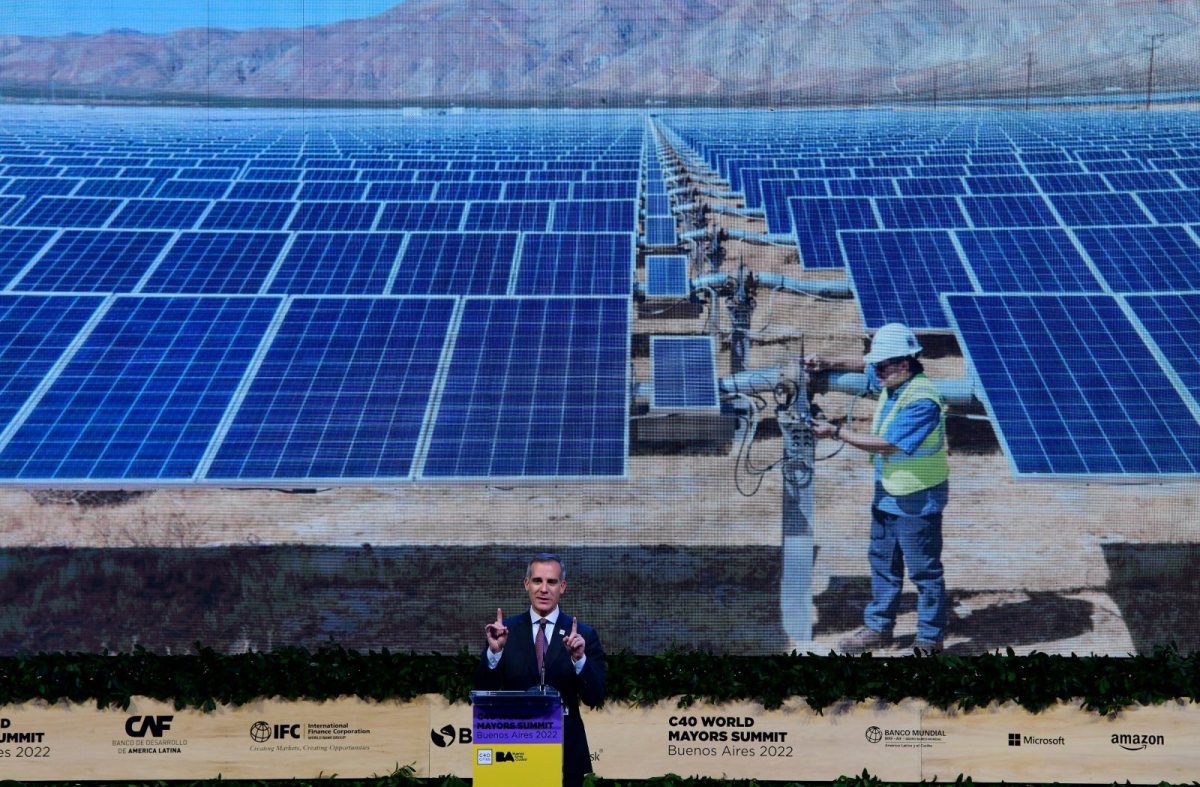
Check out the rest of the Cities + Solutions series:
- A better bike share for NOLA
- Recycling water in Healdsburg
- Facing the heat in Phoenix
- Decarbonization in Ann Arbor
- A climate plan for the Flathead Reservation
- A climate budget for Pittsburgh



